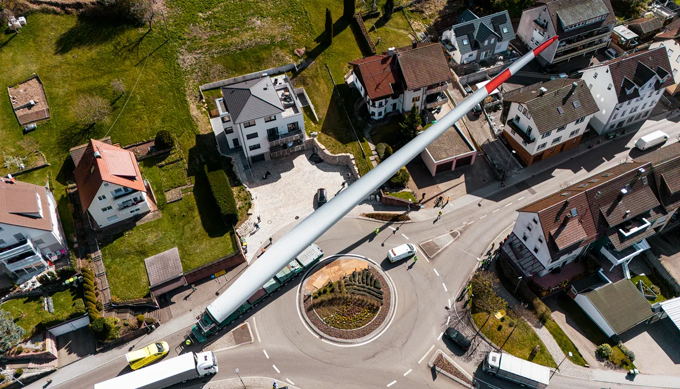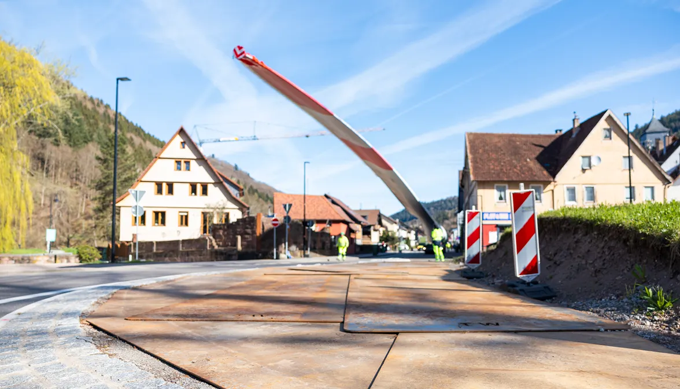Onshore wind turbines are getting taller and taller. Today's wind turbines have an average hub height of around 150 meters. The largest and longest components are the rotor blades. Transporting them is extremely difficult. Why does every millimeter count when transporting wind turbines? EnBW take a look behind the scenes of a heavy-duty transport project on behalf of the energy transition.

Wind turbines are getting higher and higher
Wind turbines are built where there is strong wind. The higher they are, the more electricity they generate. Therefore, wind turbines have made a huge technological leap in recent years: Today's turbines have an average hub height of around 150 meters – depending on the manufacturer, turbine type, and location; their rotor blades are on average 60 to 90 meters long. This makes modern wind turbines significantly more powerful than older turbines – they produce more energy on the same area under the same wind conditions. This is based on physics: if the rotor blade length is doubled, the rotor area quadruples, and the energy yield increases.
But larger wind turbines also bring new challenges. In particular, transporting components from their manufacturing site to their destination is becoming increasingly complex and expensive.
Transport only possible with heavy-duty trucks
Due to their size and weight, rotor blades, like the other components of a wind turbine, are transported to their destination on special heavy-duty transporters. Each rotor blade requires its own truck. In the case of the EnBW Prötzel II wind farm, located 50 km northeast of Berlin, 27 rotor blades were transported, each 62.5 meters long. With their load, each truck was over 90 meters long.
In addition to the components for the wind turbine, heavy-duty transport is often also required for the construction machinery and cranes required for its assembly. Here, too, the taller the wind turbine, the larger the machinery required. In total, the industry association for large-capacity and heavy-duty companies (VI GST ) estimates that up to 60,000 heavy-duty transports will be necessary per year for the planned expansion of onshore wind energy from 2025 onwards.
Prerequisite is the route study
Most roads in Germany aren't designed for the dimensions of a wind turbine. Therefore, every section of the potential route is inspected and meticulously planned in advance by transport professionals. This ultimately results in a so-called route study – this determines the route the convoy will take, what modifications are required, and what permits must be obtained. This study is carried out by the wind turbine manufacturer, who knows exactly what the individual components look like. The route is always planned for the longest part – the rotor blades. This means: If the rotor blades can manage a curve, the remaining components are no problem at all.
Wind turbine transport must be approved
Heavy goods transport is only permitted in Germany with prior approval and must be accompanied by special vehicles or the police. Therefore, every transport requires immense planning: It usually takes several weeks to obtain approval from the authorities. Usually longer. This also depends on the route the transporter is taking, whether motorways and roads have to be closed for it, and how many federal states the route passes through. Each federal state has its own regulations and requires separate permits. In addition, the affected municipalities must be involved. The same applies to residents whose properties are temporarily required for the transport. Even if they are only driven over by a few centimeters, the owners' consent is required in advance.
If the requested heavy transport becomes even a few centimeters longer or shorter on the day of departure, or if the weight deviates by even a few kilograms, the permit expires immediately. This poses a high risk for both the manufacturer and the transport company.

Infrastructure: Challenges in wind turbine transport
Curves, bends, roundabouts – a logistical challenge for any wind turbine transport. Only rarely can the heavy-duty transporters, which are more than 90 meters long, take the direct route to their destination. Most roads are too narrow or in poor condition – without reconstruction work and road closures, nothing would be possible. Traffic lights and signs are then dismantled and reassembled, roundabouts are temporarily suspended – and in rare cases, even makeshift motorway exits are constructed. Or delineators have to be removed and the lane widened with iron plates. As soon as the convoy of escort vehicles and extra-long trucks has passed, everything is dismantled again – as quickly as possible.
Transport at walking pace
Transporting wind turbines takes time. This is due to the complexity of the transport, but also to the fact that most transports can only take place at night, between 10 p.m. and 6 a.m. However, there are exceptions: for the EnBW Kälbling wind farm near Bad Wildbad, the last 15 kilometers of the transport route from the transshipment point to the destination were completed during the day. The transport took approximately one and a half weeks – at an average speed of six to seven kilometers per hour.
Two Vestas V162 wind turbines were built at the Kälbling wind farm. Each has a rotor diameter of 162 meters and a hub height of 166 meters. Starting in July, they are expected to supply electricity for approximately 5,600 households.
What a wind turbine transport costs
Reconstruction work, massive detours: All of this costs time and money. Transporting an entire wind turbine can easily cost more than a million euros. The permitting process also makes transport complex. The German Mechanical and Plant Engineering Association (VDMA) has calculated that accelerated and streamlined permitting procedures alone could eliminate around 90,000 applications per year—saving up to 70 million euros per year. Other countries are leading the way: In the Netherlands, permitting procedures take just one to five days, and applications can be submitted digitally.
In fact, the difficulties and hurdles that must be overcome when transporting wind turbines are no greater than those of other comparable large-scale infrastructure projects such as bridge and tunnel construction, the construction of airports and railway lines, or industrial facilities. Given the climate goals set by the German government – an expansion target for onshore wind energy of 115,000 MW by 2030, which corresponds to an annual gross increase of approximately 10,000 MW of wind energy capacity – the motto is: If we want to achieve the energy transition , every single wind turbine counts.
KeyFacts Energy: EnBW Germany country profile
 KEYFACT Energy
KEYFACT Energy